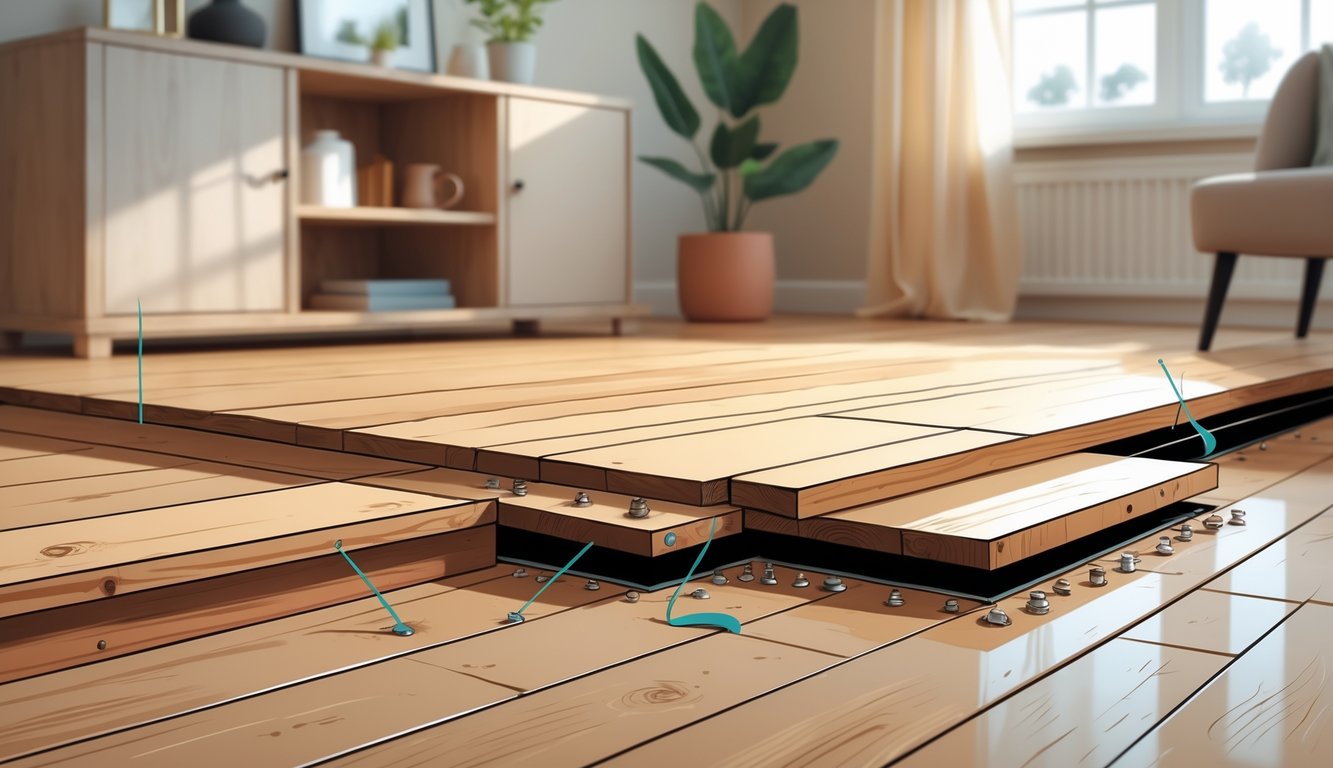
The Most Common Mistake: Poor Installation
And here’s what really gets me: it’s almost never the floorboards’ fault. It’s always, always bad installation. You’d think after all the horror stories and failed DIYs, we’d slow down and prep the subfloor right. Nope. Half the neighborhood still asks me, “Why does it sound like a circus under my kitchen tiles?”
How Improper Installation Causes Squeaks
Pull a floorboard too tight, float it too loose—either way, you get the squeaks. Sometimes it’s cheap adhesives, sometimes no underlayment at all. My friend Susan’s condo hums in winter because they skipped underlayment. Not a shock—humidity swings make the panels shift and complain.
I called a flooring contractor once, and he just said it: bad installation means boards rub or detach from the subfloor, especially when fasteners wiggle out over time. Powder isn’t a fix. It’s denial. Skip a step, misalign a tongue, and now you’re tiptoeing through life.
Oh, and John from the HOA? He swore “modern click-lock floors” would be silent. Please. Angle’s off, gap’s wrong, plank’s bowed, and the squeaks start before the paint’s even dry.
Impact on Joist and Subfloor Connections
Half the headache’s hiding underneath, trust me. The way those floor joists meet the subfloor—if there’s even a hint of slack or someone picked the wrong nails, you’re basically inviting poltergeists. I saw this article (yeah, another one) warning about loose floorboards and failed fasteners causing squeaks, and honestly, after living through a slab-on-grade disaster, I’m sold.
It just gets worse when installers “eyeball” where the joist hits the subfloor. Never ends well. Boards drift, bounce, rub, and suddenly it’s a percussion section. My cousin once tried “screwless” laminate—months later, the subfloor warped right at the joist and every time her kid ran across the living room, the whole thing creaked like a haunted house.
Premium underlayment? High-density foam? Sure, it helps, but if the screws miss their mark, who cares? I’ve seen people try to glue everything, which is just a way to delay the inevitable. What you really want is solid contact and anchoring between joist and subfloor. Most pros know that, but all it takes is a tape measure slip or someone skipping the chalk line and, boom, you’ve got problems.
Subfloor Issues to Watch For
Subfloors. Sometimes I love ‘em, sometimes I hate ‘em. Some days they’re just ancient, uneven, and creaking because the last owner decided to slap new panels over warped, dirty, maybe even still-wet old ones. Makes sense why every guide screams about subfloor prep being non-negotiable.
I watched a contractor skip the moisture test once—figured engineered hardwood didn’t care. Four months later? Boards popped, shifted, and creaked with every step. Damp subfloor, swelling, disaster. If they’d just made sure the subfloor was clean, dry, level, and rigid, none of that would’ve happened. No trick fixes physics if you lay new floors on a soggy mess.
Sometimes it’s not rot, not even moisture. It’s a couple of proud nail heads or loose screws, working their way up until vacuuming sounds like a snare drum solo. Skipping the details when you’re in a rush? Oh, I get it. But every shortcut just comes back to haunt you when the whole house starts talking back.
How Joists and Subfloors Contribute to Squeaks
Here’s what actually drives me crazy: everyone fusses over topcoat finishes, but barely anyone checks if the joist is tight against the subfloor. Squeaks? They’re almost always about how those two meet—or don’t. Who’s walking the crawlspace to triple-check fastenings? Nobody, but they should. The tiniest wiggle or gap turns into a lifetime of creaks.
Loose Joists and Movement
“It’s normal, old houses squeak!”—yeah, I’ve heard that. But here’s the thing: almost every time, it’s just wobbly joists barely attached, moving a few millimeters every step. My neighbor doubled up floor joist fasteners after reading some tech sheet from the Engineered Wood Association. Shocked everyone—suddenly, the floor was quiet. He’s still annoyed he put up with it for years.
It’s not rocket science. Joists have to stay rigid or the subfloor fasteners shear loose and the whole thing snowballs. Walk across the room, set off mini-earthquakes. If fasteners or glue fail near the joist—especially when humidity swings—wood shrinks, metal slips, squeaks get worse. People try to save a buck by skipping glue or using the cheapest subfloor, but industry folks warn that’s basically asking for trouble. Sometimes all it takes is rolling a suitcase across the floor and suddenly, the squeaks start. No one expects the suitcase.
Gaps Between Subfloor and Joist
I crawled under a friend’s house expecting termites—nope, just daylight shining through gaps between subfloor and joist. People think wood will settle flush, but nope. Gaps mean every step flexes the floor, nails rub, noise starts. Even something as dumb as dropping a can of paint can flex the subfloor just enough.
I remember reading a 2022 study (APA’s big list) that had too-tight or too-wide panel spacing listed as a cause. Fixes? Usually glue or special screw fasteners from below. Sometimes, you have to replace the joist—ugh. Nobody at the hardware store tells you that missing one screw along the joist edge can haunt you after every freeze-thaw cycle. Meanwhile, your cat jumps off a shelf and the whole floor squeaks in protest. Good luck sleeping in.